Motherboards:
AMD Performance
While the current AM2 platform cannot provide the same overall performance on a per clock basis as the Intel Core 2 Duo platforms, it does not mean AM2 is not worth considering for your gaming or work machine. In fact we still find the performance of the AM2 platform to be more than acceptable for most buyers. On a price to performance scale the AM2 series are hard to beat in the low to middle range sectors from a total platform cost.
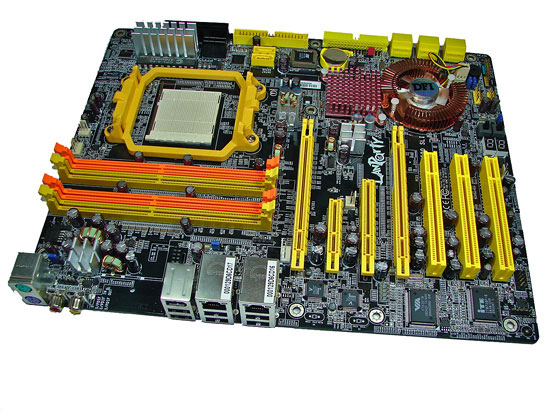
The DFI LanParty UT NF590 SLI-M2R/G is built around the NVIDIA nForce 590SLI chipset. In usual DFI fashion they have loaded the board with extra features such as two additional Serial ATA 3Gb/s ports via the Silicon Image 3132 chipset, the Karajan audio module featuring the Realtek ALC885 8-channel HD audio codec, and IEEE 1394 support. The board supports AM2 socket processors, features two full speed PCI Express x16 slots (SLI support), one x8 PCI Express slot, one x1 PCI Express slot (x4 physical), and three PCI 2.2 capable slots. The board is an excellent overclocker taking our X2 3800+ up to 3.08GHz while DDR2 speeds have reached a little over 1200, although the extra bandwidth is wasted due to the current clock/memory controller limitations of the AM2. We will be comparing this board to the Asus CrossHair and Abit AN9-32X shortly to see who reigns supreme at the high-end in AM2 performance.
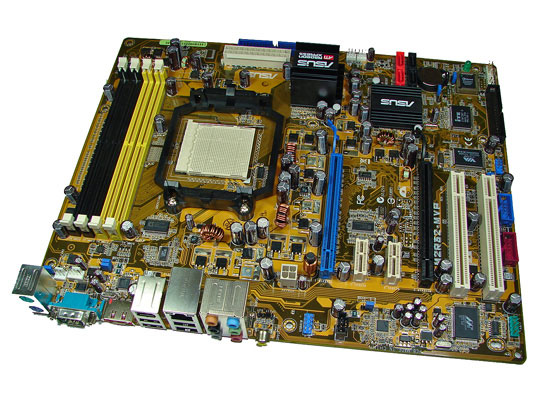
The ASUS M2R32-MVP is based on the AMD/ATI RD580 chipset (CrossFire Xpress 3200) that offers CrossFire capability on the AM2 platform. The M2R32-MVP is equipped with the SB600 Southbridge that features four Serial ATA 3Gb/s ports with support for RAID 0, 1, and 0+1. ASUS also supplies the JMicron 360 SATA controller that provides the single e-SATA port on the board. The board supports AM2 socket processors, features two full speed PCI Express x16 slots (CrossFire support), two x1 PCI Express slots, and two PCI 2.3 capable slots. The board is also equipped with an ADI 1988A 8-channel HD audio codec. Although the board is targeted to the mid-range performance sector it has offered excellent performance and fairly good overclocking rates up to 315HTT to date. We will be comparing this product against the recently released EP-AD580 XR board from EPoX.
AMD mATX
We have several mATX boards supporting the AM2 processor series that we will present in our upcoming roundup. The products we will briefly cover today are just a few examples of the boards that will be included. While most of our boards are based on the NVIDIA nForce 6100 chipset, we do have a couple of AMD/ATI RS485 boards along with a VIA K8M890 based board. We are hoping to receive our first AMD RS695 motherboard shortly that features onboard X700 level graphics performance.
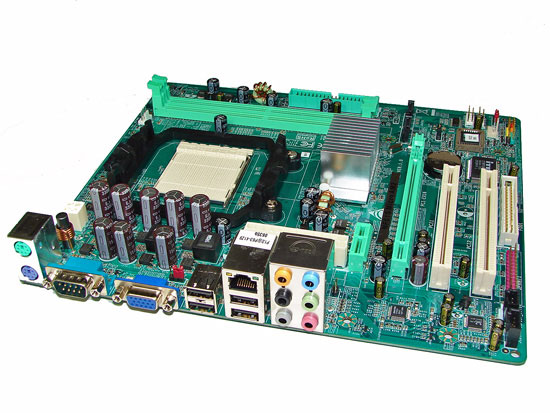
The Biostar NF61S MicroAM2 board is based on the NVIDIA MCP61S (GeForce 6100/nForce 405) chipset that offers good onboard video performance with the ability to upgrade to the latest graphics card technology via the x16 PCI Express slot. The board supports 2GB of DDR2 memory, HD audio via the Realtek ALC861VD, and 10/100 Fast Ethernet. The board is actually a uATX form factor and in testing has worked flawlessly to date.
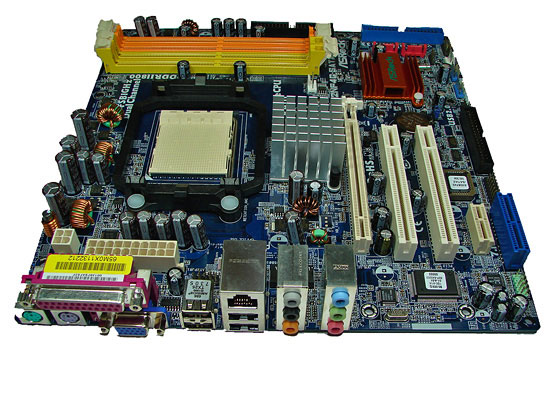
We have several ASRock motherboards to review in the AM2 category and we are hoping to have the new ALiveNF6G-DVI in time for the roundup. The AM2NF4G-SATA2 board is based on the NVIDIA GeForce 6100 and nForce 410 chipsets that offer very good system performance in a mATX form factor. The board has one x16 PCI Express slot, one x1 PCI Express slot, and two PCI slots. The board supports 8GB of DDR2 memory, HD audio via the Realtek ALC888, 10/100 Fast Ethernet, and two Serial ATA 3Gb/s ports along with two ATA133 IDE connectors. The board is also Vista Premium ready.
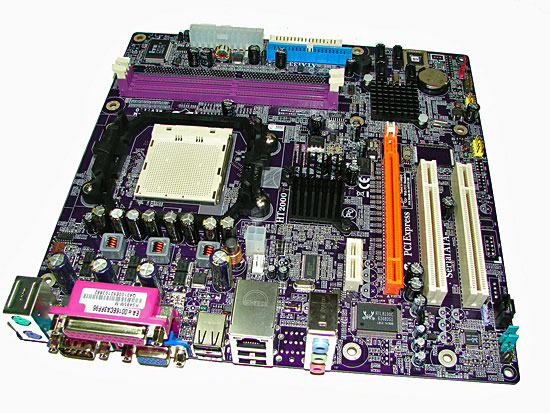
The ECS RS485M-M motherboard is built on the AMD/ATI RS485 (Radeon Xpress 1100) and SB460 chipsets that offer balanced system performance. The board supports 16GB of DDR2 memory, 6-channel AC-97 audio via the Realtek ALC655, four SATA 1.5Gb/s ports, and 10/100 Fast Ethernet. The performance of thise board and that of the MSI based on the same chipset actually surprised us to some degree. We expect to see further performance improvements with the updated RS695 chipset.
AMD Performance
While the current AM2 platform cannot provide the same overall performance on a per clock basis as the Intel Core 2 Duo platforms, it does not mean AM2 is not worth considering for your gaming or work machine. In fact we still find the performance of the AM2 platform to be more than acceptable for most buyers. On a price to performance scale the AM2 series are hard to beat in the low to middle range sectors from a total platform cost.

The DFI LanParty UT NF590 SLI-M2R/G is built around the NVIDIA nForce 590SLI chipset. In usual DFI fashion they have loaded the board with extra features such as two additional Serial ATA 3Gb/s ports via the Silicon Image 3132 chipset, the Karajan audio module featuring the Realtek ALC885 8-channel HD audio codec, and IEEE 1394 support. The board supports AM2 socket processors, features two full speed PCI Express x16 slots (SLI support), one x8 PCI Express slot, one x1 PCI Express slot (x4 physical), and three PCI 2.2 capable slots. The board is an excellent overclocker taking our X2 3800+ up to 3.08GHz while DDR2 speeds have reached a little over 1200, although the extra bandwidth is wasted due to the current clock/memory controller limitations of the AM2. We will be comparing this board to the Asus CrossHair and Abit AN9-32X shortly to see who reigns supreme at the high-end in AM2 performance.

The ASUS M2R32-MVP is based on the AMD/ATI RD580 chipset (CrossFire Xpress 3200) that offers CrossFire capability on the AM2 platform. The M2R32-MVP is equipped with the SB600 Southbridge that features four Serial ATA 3Gb/s ports with support for RAID 0, 1, and 0+1. ASUS also supplies the JMicron 360 SATA controller that provides the single e-SATA port on the board. The board supports AM2 socket processors, features two full speed PCI Express x16 slots (CrossFire support), two x1 PCI Express slots, and two PCI 2.3 capable slots. The board is also equipped with an ADI 1988A 8-channel HD audio codec. Although the board is targeted to the mid-range performance sector it has offered excellent performance and fairly good overclocking rates up to 315HTT to date. We will be comparing this product against the recently released EP-AD580 XR board from EPoX.
AMD mATX
We have several mATX boards supporting the AM2 processor series that we will present in our upcoming roundup. The products we will briefly cover today are just a few examples of the boards that will be included. While most of our boards are based on the NVIDIA nForce 6100 chipset, we do have a couple of AMD/ATI RS485 boards along with a VIA K8M890 based board. We are hoping to receive our first AMD RS695 motherboard shortly that features onboard X700 level graphics performance.

The Biostar NF61S MicroAM2 board is based on the NVIDIA MCP61S (GeForce 6100/nForce 405) chipset that offers good onboard video performance with the ability to upgrade to the latest graphics card technology via the x16 PCI Express slot. The board supports 2GB of DDR2 memory, HD audio via the Realtek ALC861VD, and 10/100 Fast Ethernet. The board is actually a uATX form factor and in testing has worked flawlessly to date.

We have several ASRock motherboards to review in the AM2 category and we are hoping to have the new ALiveNF6G-DVI in time for the roundup. The AM2NF4G-SATA2 board is based on the NVIDIA GeForce 6100 and nForce 410 chipsets that offer very good system performance in a mATX form factor. The board has one x16 PCI Express slot, one x1 PCI Express slot, and two PCI slots. The board supports 8GB of DDR2 memory, HD audio via the Realtek ALC888, 10/100 Fast Ethernet, and two Serial ATA 3Gb/s ports along with two ATA133 IDE connectors. The board is also Vista Premium ready.

The ECS RS485M-M motherboard is built on the AMD/ATI RS485 (Radeon Xpress 1100) and SB460 chipsets that offer balanced system performance. The board supports 16GB of DDR2 memory, 6-channel AC-97 audio via the Realtek ALC655, four SATA 1.5Gb/s ports, and 10/100 Fast Ethernet. The performance of thise board and that of the MSI based on the same chipset actually surprised us to some degree. We expect to see further performance improvements with the updated RS695 chipset.










19 Comments
View All Comments
mino - Sunday, December 3, 2006 - link
Well, Sempron 2600+ goes for as low as $35... seems peanuts to the board...VooDooAddict - Sunday, December 3, 2006 - link
You see any other mini ITX boards that are 64-bit capable and have onboard video with DVI and 3D capable of running vista?Compare to other Mini ITX boards and you'll see it's comperable.
I would have liked to see it AM2 with the prospect of using the SFF edition X2s and aking the PCI slot PCIe x16 instead.
orion23 - Sunday, December 3, 2006 - link
I'm sure this has been asked before, but so what....Why is it that Anandtech doesn't review other critical products that are needed for a complete PC building project?
Many times we are told which motherboard, processor or GPU is the best, but other important parts such as the PSU or the CPU cooler are never reviewed here, reason why so many of us have to go elsewhere to look at some mediocre reviews done by some not so reputable sites.
Come on Anandtech, review a few more, different components from time to time, besides, it wouldn't hurt you to put more than 1 article a week.....
yyrkoon - Sunday, December 3, 2006 - link
Owning one of these boards, I feel compelled to share my opinion of it.When I purchased it through newegg, I was very enthusiastic, about getting it via UPS. When all my parts finally arrived (less than 24 hours later) I pieced the parts together, and TRIED to install XP pro. The series of problems I ran into along the way, were as follows:
1) Hooked up a USB DVD/CD writter, to boot from, and before I could even get into bluescreen setup part of XP, the system would hang. I chocked this up to the system not being able to run from a USB opitcal drive (after playign with the BIOS a few times, I'd like to add), and finally gave up, and put the optical drive on the secondary IDE connector.
2) System still wouldnt make it into the blue screen part of setup (hanging before), and I was starting to get worried, until I finally figured out the SATA drive was was what was causing the issue, so I disconnected it, and viola . .
3) Keep in mind, #2 was happening during WinPE, so was in no way driver related. Anyhow, after finally getting the OS installed on the IDE drive I placed in it, I reconnected the SATA drive, and it showed up . . .
3) After about a week, I finally decided that booting from an IDE HDD, was un acceptable, and emailed technical support . . . 2 days later . . .no reply. So calling technical support, I was greated with a friendly rep, who then instructed me how to IN CORRECTLY setup my system. However, this representative, gave me his dirrect email address, and we corresponded over the course of about 5 days, until I finally found a working solution (on my own, with a bit of help from him). Keep in mind, that "Jimmy" was very helpfull, and without his help, I may have not been able to fix this issue in such a short time period.
Long story short, the SATA drive needs to be connected, you MUST enable SATA RAID in the BIOS, and in the RAID BIOS configuration, if you only have one HDD attached, you MUST set it up as a JBOD volume. If you do not have the drivers on a floppy, or do not have a floppy in your system period (like me), part of the pre install process, it would BEHOOVE you to slipstream the SATA drivers, and RAID drivers from the install CD provided with the motherboard.
Once I had all this working, I set out to OC the system, and finally arrived at a top OC of around 2.76GHZ (on a AM2 3800+ single core), but keep in mind, there is no chance of raising voltages for memory, or CPU, unless, perhaps, you hard mod the board. Also, for the board to be fairly stable, I had to drop the multiplier to 10x vs. 11x, although my memory (Corsair 5-5-5-18 6400 XMS) was able to run at 4-4-4-12 timings, at 880MHZ DDR2.
Other things I've noticed about this board and Asrock:
1) technical support informed me that this board does not support NCQ, but is a SATA2 board, funny, NCQ is part of the SATA2 specification I thought . . .
2) this system has not been stable, and running for more than 9 days at a time, and typically, it likes to crash, hang, or force a reboot about once every 4-5 days.
3) Asrock does not seem to have the driver support of other well known companies, this board was released, 3 weeks later, all drivers were appearantly perfect, and havent been updated since.
Now I do realize, this is a budget board, however, comming from using 100% ABIT boards, perhaps I'm a bit spoiled ? I mean sure, having only paid $54 USD for it, perhaps I can not expect too much ? My advice . . . would be to stay away, if you can afford at least $30 more, buy a Gigabyte board or something, which is what I should have done. Sure, I'd have $30 less today, but atleast if this were an ABIT, or Gigabyte board, I'd have the odd BIOS update, or driver to look forward to.
mino - Sunday, December 3, 2006 - link
AsRock as usual. One gets what one pays for. ...Had similar experience some time ago - have SiS748 running at FSB/DDR333 speeds as 400 is completely unstable, also any TV tuner(AIW or PCI) crashes the system on regular basis.
yyrkoon - Monday, December 4, 2006 - link
Well, one fairly cool thing is that I just installed Vista RC2 (had to do some fenagling to get the ISO, but was easy to get CD-KEYS from MS), anyhow, once Vista installed, the majority of my devices were auto detected, and installed. Matter of fact, the only device that wasnt detected, was a 4-5 year old Ultra 100 Promise PCI ATA controller (which i easily fixed by going to Promises site, and installed their XP drivers for it).Graphics sub system weighs in at a 5.9 score with a 7600GT, but overall score is 4.2 because of the HDD Installed it on (ATA 100). I must say, I'm enjoying Vista, although performance wise, it needs a bit of work to catch up to XP pro. Games play slower, and my 3xRAID0 array that benched at over 100MB/s in XP pro, only does 78MB/s in Vista :(
BUT Aero looks awesome !
crydee - Sunday, December 3, 2006 - link
Are you going to do a review of that PSU with respect to SLI G80 or in specific cases?Jedi2155 - Sunday, December 3, 2006 - link
Are you guys doing a review of the Striker Extreme?I was very interested in that board. Even though I already purchased a eVGA 680i board (I was under a time constraint to get my new system up), I was wondering if I made a mistake and should've waited for the Striker to get in stock...Buy.com had it for $350-20 google checkout which meant the striker was on sale for $330. Unfortunately it wasn't in stock :(.
MemberSince97 - Sunday, December 3, 2006 - link
WhereTF are the new AMD/775 Boards....